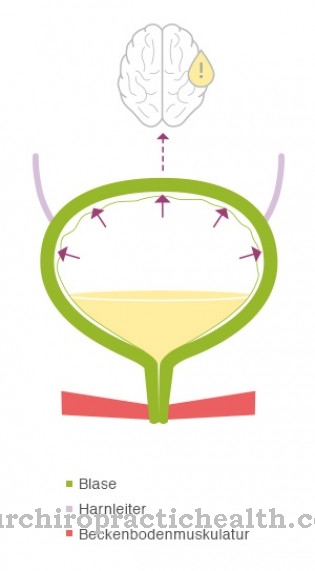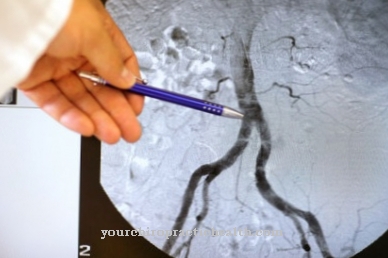The Detrusor-sphincter dyssynergy is a neurogenic disorder in the interaction of the detrusor and sphincter, both of which are involved in emptying the bladder. The external sphincter reflexively contracts at the same time as the detrusor and the bladder does not empty adequately. There is a choice of conservative and surgical procedures for treatment.
What is detrusor sphincter dyssynergy?

© sakurra - stock.adobe.com In the case of dyssynergy, the interaction of a functional unit made up of different structures is disturbed. Detrusor-sphincter dyssynergy is a dysfunction of the urinary bladder in which the interplay between the urethral muscles and the bladder muscles is disturbed. More precisely, the phenomenon corresponds to a lack of coordination of the Detrusor vesicae muscle the bladder and external urethral sphincter External urethral sphincter muscle.
The coordination of these two muscles plays a decisive role in the process of emptying the bladder in the sense of micturition. Since a related coordination disorder of the muscles is due to the innervation and nerve control of the muscle elements, detrusor-sphincter dyssynergy is one of the neuromuscular dysfunctions of the urinary bladder.
This is a neuromuscular bladder emptying disorder. Detrusor-sphincter dyssynergy is often associated with weakness in the pelvic floor muscles, which is favored by changes in physiological age.
causes
The primary cause of detrusor-sphincter dyssynergy is to be found in the neuromuscular context. The neuromuscular disorder can be due to several primary causes. Instead of a relaxation of the external sphincter, a reflex spastic contraction of the muscle occurs during micturition, which occurs simultaneously with the contraction of the detrusor. The urine flow is insufficient.
This leads to the formation of residual urine, which causes a consecutive urinary stasis. The coordination of the two muscles is impaired by neurogenic disorders that affect central bladder control. Such disorders are mostly the result of lesions in the central nervous system. These lesions can occur in the context of a general disease, for example as a symptom of multiple sclerosis.
On the other hand, they can also go back to trauma, bleeding or tumors and degenerations. If the lesions do not affect the control center in the brain, the most common lesions are thoracic or cervical spinal cord lesions.
You can find your medication here
➔ Medicines for bladder and urinary tract healthSymptoms, ailments & signs
The clinical picture of patients with detrusor-sphincter dyssenergy corresponds to that of pollakiuria. This is a micturition disorder that manifests itself in an increased frequency of emptying the bladder to small amounts of urine. So the amount of urine is not increased. Only the micturition passages increase.
As a complication of detrusor-sphincter dyssynergy, various additional symptoms can occur, which are mainly due to the residual urine in the bladder. This residual urine can be an optimal breeding ground for bacteria and, as a result, greatly increase the risk of recurrent urinary tract infections.
Occasionally, in the course of detrusor-sphincter dyssenergy, symptoms such as vesicorenal reflux appear, which in turn can cause ascending infections and, in extreme cases, result in pressure atrophy of the kidney parenchyma. With this atrophy, the connective tissue of the kidneys breaks down bit by bit. Therefore, this complication in particular must be prevented by early treatment.
diagnosis
The doctor first suspects dyssynergy after taking the anamnesis. For the diagnosis and clarification of detrusor-sphincter dyssynergy, the doctor has various examination methods available. One of the most important examinations in this context is the radiological representation of the micturition process with contrast agent administration.
At the same time as the X-ray display, a bladder pressure measurement is carried out using video urodynamics. In most cases, an isolated pressure measurement takes place within the urethra or bladder. This procedure is usually equivalent to urethro-cystotonometry. In addition to these diagnostics, the doctor can use sonographic findings.
Above all, the urinary bladder should be examined by ultrasound in order to determine the residual amount of urine and to discover additional complications for the urinary system. The prognosis is considered to be relatively favorable as long as no complications have occurred.
Complications
Because of the detrusor-sphincter dyssynergy, the affected person usually suffers from problems with emptying the bladder. These complaints usually have a very negative effect on the patient's psyche, so that numerous psychological complaints and depression can occur. In most cases the patient can only expel very small amounts from the bladder and therefore has to go to the toilet more often.
This manifests itself in a decreased quality of life. It can also lead to a urinary tract infection, which is associated with severe pain when urinating. The tissue on the kidney is slowly broken down, so that in the worst case, the kidney can completely lose its function. In most cases, the treatment is causal and depends on the underlying disease.
It is not possible in all cases to completely limit the detrusor-sphincter dyssynergy. Different therapies are often used to stimulate the bladder. In severe cases, the patient may need an indwelling catheter in order to be able to cope with everyday life. Antibiotics are used for inflammation and infections. There are usually no more complications with treatment.
When should you go to the doctor?
In the case of detrusor-sphincter dyssynergy, a doctor should be consulted if there are problems emptying the bladder. In most cases, the bladder has to be emptied relatively frequently and only very small amounts of urine escape. Many sufferers also develop psychological complaints or depression, so that psychological treatment may also be necessary. Treatment by a doctor is also advisable if a urinary tract infection occurs.
This is usually associated with severe pain. Other kidney problems may indicate detrusor-sphincter dyssynergy and should be investigated. An early diagnosis can stop the further breakdown of kidney tissue. The diagnosis and treatment of detrusor-sphincter dyssynergy can usually be made by an internist. Since various therapies may be necessary during treatment, these are usually carried out by specialists. Possible infections are treated with the help of antibiotics.
Doctors & therapists in your area
Treatment & Therapy
Detrusor-sphincter dyssynergy is usually treated with causal therapeutic approaches. In the course of such a causal therapy, the primary cause of the disease should be eliminated. The aim of the treatment thus corresponds to a coordinative improvement in the muscle interplay. Targeted training of the pelvic floor muscles, for example, can help improve coordination.
In addition to pelvic floor training, patients are advised to self-stimulate the bladder. This stimulation usually corresponds to lightly tapping the organ. The gentle tapping movements should ideally be performed regularly and may improve general bladder function. If the person concerned is only able to empty their bladder spontaneously to an extremely inadequate extent, self-catheterisation is up for discussion.
Alternatively, depending on the patient's ability, suprapubic indwelling catheters can be placed. If conservative treatment does not improve, an invasive treatment option can be discussed. A surgical incision in the sense of a sphincterotomy can help. Paralysis of the external sphincter through the injection of botulinum toxin is also possible in individual cases.
In a conservative way, the muscle detrusor can also be inhibited by the administration of anticholinergic drugs. If urinary tract infections are already present, these infections are treated with antibiotics in acute cases. In most cases, the therapy is a combination of several of the options mentioned.
Outlook & forecast
Detrusor-sphincter dyssynergy leads to various limitations in the patient's life if the disease is not treated. As a rule, the disease has a very negative effect on the person concerned, so that they have to go to the toilet more often. Only a small amount of urine comes out, so residual urine remains in the bladder.
For this reason, if left untreated, detrusor-sphincter dyssynergy often leads to infections in the urinary tract and also to vesicorenal reflux, which can cause further infections. The detrusor-sphincter dyssynergy also destroys the kidney tissue over time, so that in the worst case, kidney failure can occur. The patient has to rely on dialysis or a donor kidney to avoid death.
Treatment for this condition can be done differently and depends on the stage of the disease. In most cases, however, the symptoms are well limited and the quality of life of the person affected is increased again.
There are no particular complications. In some cases, those affected depend on a catheter. Early diagnosis and treatment have a positive effect on the further course of the disease.
You can find your medication here
➔ Medicines for bladder and urinary tract healthprevention
The detrusor-sphincter dyssynergy in the context of neurological diseases such as multiple sclerosis can hardly be prevented. Age-related dyssenenergies of the two muscles can be counteracted at least to a limited extent by regular training of the pelvic floor muscles. Prophylactic tapping of the bladder can also support bladder function.
Aftercare
In detrusor-sphincter dyssynergy, follow-up measures are usually severely limited. The person concerned is primarily dependent on early treatment so that there are no further complications and complaints. The earlier the disease is detected, the better the further course.
If the detrusor-sphincter dyssynergy is not treated, the symptoms usually worsen dramatically, and in the worst case even death of the person concerned. The treatment of detrusor-sphincter dyssynergy can take place through special training or surgery. As a rule, the severity of the disease determines the further treatment.
Some of the exercises from the therapies can also be performed by the person concerned in their own home, which may accelerate the healing of detrusor-sphincter dyssynergy. When taking medication, those affected should ensure that they are taken regularly and that the dosage is correct in order to limit the symptoms permanently. Self-healing cannot occur with this disease. After a possible procedure, it is advisable for those affected to rest and take care of their body.
You can do that yourself
Basically, it is first important not to be ashamed of the lack of urine control. This can even exacerbate the symptoms from the psychological pressure.There are many tools that can catch the urine so that it cannot be seen. These include, with little urine loss, pads to diapers or urinal condoms.
A lack of urine control has several causes, so that science and trade have enough options on the market that can collect the urine. This means that outsiders have no way of noticing. Patients should be open about this, especially if they want advice. It's a medical problem that is definitely not to be ashamed of.
In addition, the pelvic floor can be strengthened and trained in physiotherapy. In this way, the urinary bladder muscles can be stimulated and improved. The bladder can also be tapped to stimulate it. It is important to have an expert show you the method correctly. Exercising regularly is the cornerstone of improvement. The pelvic floor training does not bring one hundred percent success after a single exercise, but the muscle behaves like any other muscle in the body that needs to be stimulated regularly.
Patients can exchange ideas in self-help groups for incontinence. There are many helpful tips to be found online, especially.






.jpg)

.jpg)



















